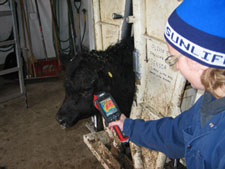Castration Comforts - New Eyes On An Old Issue

AAFC technicians at the Lethbridge Research Centre take an infrared image of cattle to measure body temperature, as one of the indicators showing the effect of band versus surgical castration.
This article was originally published February 2010 on Pages A4 in the Prairie Post's Bullbreeders 2010.
Over the last 10 years, the proper management of pain in food-producing animals has become a matter of increasing public concern and growing interest by legislative bodies worldwide. Castration is a necessary and widely used husbandry procedure in Canadian beef production. The procedure is done to facilitate management, reduce aggressive and sexual behaviors, and improve meat quality.
However, according to the American Veterinary Association, castration is one of the most painful experiences in a calf's life, producing both acute and chronic pain and stress. Although many producers castrate their bull calves prior to weaning, there are still some animals that slip through the cracks and arrive at the feedlot intact (incidence ranging from 2% to 30%).
Scientists have delved further into the response of calves that are castrated on arrival at the feedlot. In previous research, they found that growth rate, feed intake and immune response can be reduced, while stress hormones in the blood as well as behavioural responses indicative of pain can be elevated.
As a result of these findings, the public and various organizations have begun to lobby the government to legislate the use of anaesthetics and analgesics for pain mitigation related to castration. Currently, several countries in the European Union have regulations dictating that bull calves cannot be castrated without the use of anaesthetics after one week of age. If Canada has any hope of opening new markets into Europe, we will have to alter our current management strategies. Therefore, reducing pain during and after castration may improve performance, welfare, food safety and world market access.
A recent study has shown that caudal epidural anaesthesia plus an intravenous painkiller at the time of castration reduced fecal E. coli shedding, whereas a subcutaneous painkiller plus intratesticular anaesthesia improved feed intake and body weight. The work was done by scientists at Agriculture and Agri-Food Canada's Lethbridge Research Centre in collaboration with researchers at the University of Calgary's Veterinary School, the University of Manitoba and the University of Saskatchewan's Western College of Veterinary Medicine. As well, they found that the onset of detrimental effects in calves occurred at different times (i.e., number of days post castration) for surgical and band castration. For example, surgically castrated calves experienced negative effects between two to seven days after castration, while banded calves experienced similar effects between four to five weeks after castration. These previous studies did not consider pain mitigation when the animals exhibited the greatest pain responses (acute and chronic). Currently, no long-term pain mitigation options are available for producers to use in cattle.
The research group headed by Dr. Karen Schwartzkopf-Genswein of the Lethbridge Research Centre is continuing to search for easy-to-use and effective pain mitigation strategies (acute and chronic) for knife and band castration of beef cattle. Identification of such strategies is a proactive step in ensuring the industry has a proven management practice to deal with pain in cattle. The new information gleaned from their research will be particularly useful in the event that pain mitigation is legislated, not to mention the possibilities for opening up new cattle markets.
Dr. Karen Schwartzkopf-Genswein
Research Scientist - Beef Production Systems
Agriculture and Agri-Food Canada
Lethbridge Research Centre, Lethbridge, Alberta
